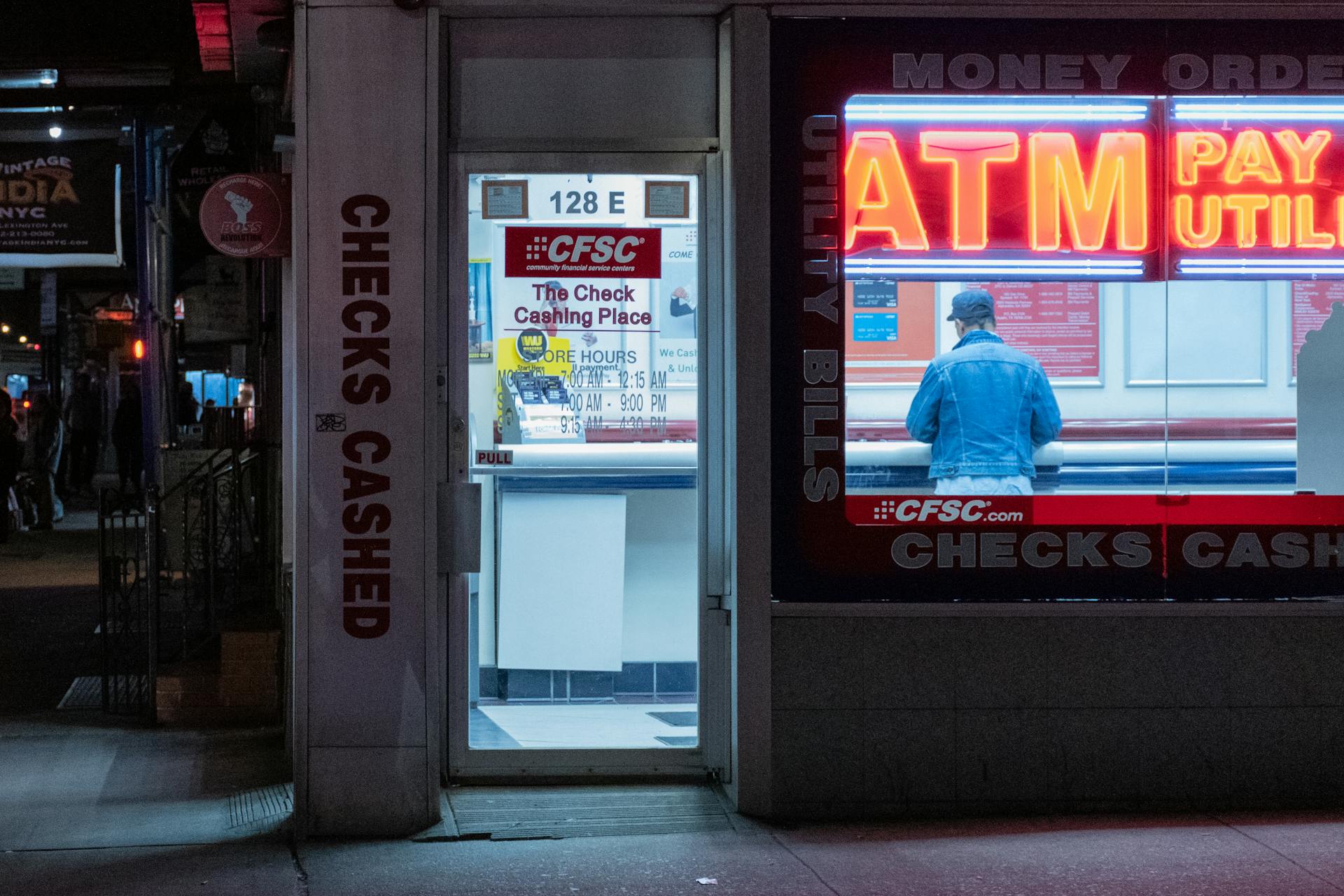
A merchant cash advance can be a quick way to get the cash your business needs, but it's essential to understand the pros and cons before making a decision.
The cost of a merchant cash advance is typically much higher than a traditional loan, with interest rates ranging from 20% to 350% per year.
Merchant cash advances are often used by businesses that need a quick influx of cash, such as restaurants or retail stores that have seasonal fluctuations in sales.
You'll need to repay the advance through a percentage of your daily credit card sales, which can be a significant burden if your sales slow down.
Recommended read: Merchant Cash Advance Sales Training
What Is a Merchant Cash Advance?
A merchant cash advance is a type of financing that allows businesses to borrow money from a lender in exchange for a percentage of their future credit card sales.
This type of financing is often used by businesses that have poor or no credit history, as it doesn't require a traditional credit check.
The lender advances a lump sum of money to the business, which is then repaid through a percentage of the business's daily credit card sales.
Typically, this percentage can range from 10% to 20% of daily sales, and the repayment period can last anywhere from a few months to several years.
The lender will also charge a fee, which can range from 25% to 50% of the initial loan amount, in addition to the interest.
For example, if a business borrows $10,000 with a 30% fee, they will owe the lender $13,000 over the repayment period.
This type of financing can be beneficial for businesses that need quick access to cash to cover unexpected expenses or take advantage of new opportunities.
However, the fees and interest rates associated with merchant cash advances can be very high, making them a costly option for businesses.
Take a look at this: Money Lender Business Loan
Pros and Cons
Merchant cash advances offer many conveniences, but they come with a high price. They can help when your business needs cash immediately to cover day-to-day expenses.
Nearly any business with card sales can qualify for a merchant cash advance, even with bad credit. This makes them a viable option for businesses that don't qualify for loans with traditional banks.
Their high fees and aggressive repayments may not be ideal for businesses with persistent cash flow problems.
Business Card
Business cards can be a solid option if your business doesn't need much funding or doesn't qualify for business loans. They set a credit limit, such as $50,000, and typically offer 1 percent to 5 percent rewards for purchases.
APRs can range anywhere from 14.00 percent to 28.00 percent, which is higher than what you'd pay in some other forms of financing. If you don't have good credit, you'll need to find credit-building business credit cards.
The Spark 1% Classic is designed for fair credit borrowers and doesn't charge an annual fee. It also offers 1 percent cash back on all purchases, which can be a nice perk.
Business credit cards can be riskier than other forms of financing, as the rates can be higher and there is the potential for a vicious cycle of debt if you're unable to make payments.
Broaden your view: How to Get a Small Business Loan without Collateral
Business Lines
Business lines of credit can be one of the easiest types of conventional business loans to qualify for. Online lenders keep eligibility requirements loose, such as requiring a 600 minimum credit score and as little as six months in business.
Business lines of credit can provide your business with a moderate amount of working capital to cover day-to-day expenses, with loan amounts ranging from $1,000 to $250,000.
You have fixed repayment terms once you draw funds, but your credit limit replenishes as you repay the loan.
Unlike other lending options, a business line of credit allows you to only use what you need and pay interest on that, rather than getting a larger lump sum than your business requires.
Business lines of credit must be repaid with interest, so there is a risk involved if cash is tight when you must repay what you borrow.
You might like: No Doc Business Lines of Credit
Pros
Merchant cash advances offer many conveniences that can be a game-changer for businesses in need of quick funding.
One of the main advantages is its flexibility and accessibility. Unlike traditional loans, merchant cash advances don't require a long application process or a good credit score.
Businesses can receive the funds they need quickly, often within a few days or weeks, which can be a huge relief for those facing cash flow problems.
This financing option is also convenient because it doesn't require a lump sum repayment, but rather daily or weekly payments, which can be more manageable for businesses with fluctuating income.
The factor rate fees associated with merchant cash advances can be high, but they are often more transparent than traditional loan interest rates.
However, it's worth noting that the fees paid on an MCA can translate into interest rates of 50 percent to 100 percent or higher, so it's essential to carefully review the terms and conditions before signing up.
Here are some key benefits of merchant cash advances at a glance:
Pros and Cons

Merchant cash advances can be a convenient option for businesses with cash flow problems, but it's essential to consider the pros and cons before applying.
One of the main advantages of merchant cash advances is their flexibility and accessibility. Nearly any business with card sales can qualify, even with bad credit.
However, the convenience comes with a high price. Factor rate fees can cost more than conventional loans, translating into interest rates of 50 percent to 20 percent or higher.
You'll be on the hook with daily or weekly repayments until the advance is fully repaid. This aggressive repayment schedule can strain a business's cash flow.
Merchant cash advances don't report your payments to the credit bureaus, so you won't improve your credit through this financing option.
Here are the typical financing fees for MCAs:
- Factor rates: 1.1 to 1.5, multiplying that rate by the amount you're borrowing
- Origination fee: a percentage of the borrowed amount
- Underwriting or funding fee: a percentage of the borrowed amount or a flat fee
- Administrative fee: a flat fee covering the cost of processing or maintaining the MCA agreement
Repayments start the day after you receive your funds, typically through a daily deduction from your business's debit and/or credit card transactions. Payments can also be made weekly.

To calculate your repayment term, you can estimate based on how much you make in sales. However, the terms may be drawn out if sales dip at any point. A 10% to 20% holdback rate determines how much of your revenue goes toward repayment each day or week.
For example, if your business generates $2,500 in revenue per day with a 10% holdback rate, you'll pay around $250 per day. According to these terms, it would take around 12 months to repay just the principal balance on a $90,000 MCA.
Readers also liked: Merchant Cash Advance Default Rate
Repayment Terms
Repayment terms for merchant cash advances can be complex and confusing.
Some lenders offer repayment terms based on a percentage of your credit card sales, which can be deducted automatically by your credit card processor.
The repayment period is usually short, typically 18 months or less, depending on the lender.
In some cases, repayment can be made via automatic debit from your checking account to the lender's account, known as ACH withholding.
This means that the lender will take its share of your credit card sales and transfer the rest to your bank account, using a lockbox or trust account withholding method.
Repayment terms can also involve fixed payments, but this is less common than percentage-based repayment.
Consider reading: Private Money Lender List
Alternatives to Merchant Cash Advances
If you're considering a merchant cash advance, it's essential to explore other options first. Business loans from your bank or credit union can provide affordable financing with lower risk.
You don't have to put everything on the line for quick cash. Small business credit cards with rewards and 0% introductory APR can be a better choice.
Alternatives like SBA loans, small business grants, business lines of credit, invoice factoring, crowdfunding, and equipment leasing can also be viable options. These alternatives can help you find a solution that works for the long run.
Consider the following alternatives to merchant cash advances:
- Business loan from your bank or credit union
- Small business credit card with rewards/incentives, like 0% introductory APR
- SBA loans or other federal loans for small businesses
- Small business grants
- Business line of credit
- Invoice factoring
- Crowdfunding
- Equipment leasing
Invoice Financing
Invoice financing uses outstanding invoices to provide a cash advance, allowing you to access funds without selling your future revenue.
You're responsible for collecting the payments from your clients instead of the financing company, which means you'll need to handle the administrative tasks of invoicing and payment collection.
The financing company advances a percentage of the total invoice amount to you, and you'll receive the remainder after they've taken out their fees.
Invoice financing is another option to consider if you're looking for a way to access cash without selling your future revenue, and it can be a good choice if you're comfortable with handling the payment collection process.
Curious to learn more? Check out: Can You Get a Loan with No Bank Account
Term Loans
If you're looking for alternatives to merchant cash advances, you might want to consider term loans. They provide a lump-sum payment upfront, but unlike merchant cash advances, repayments are made on a fixed schedule.
Short-term loans are one option, offering fixed repayments over a short time period, usually six to 24 months. This can be a good choice for businesses that need quick funding.
Asset-based loans are another option, secured by the value of assets rather than cash flow. This makes them more accessible to businesses with less-than-perfect credit but significant assets.
Bridge loans are short-term loans designed to cover financial gaps temporarily until your business finds other financing. Interest rates may be higher than conventional term loans, but lenders approve these loans more quickly.
Equipment loans offer payment to purchase, upgrade or refinance commercial equipment, and are secured by the equipment itself. This can provide lower interest rates, as low as 5 percent.
Intriguing read: Short Term Bridging Loan
SBA loans are backed by the U.S. Small Business Administration and often come with long repayment terms and low interest rates. This can make repayments more manageable for businesses that don't qualify for conventional term loans.
Here are some key features of the different types of term loans:
Frequently Asked Questions
Can a merchant cash advance hurt your credit?
Yes, a merchant cash advance can hurt your credit, with a 5-point ding if the provider pulls your credit score, and potentially lower scores if you default on the debt. Defaulting on a merchant cash advance can have serious credit consequences, so it's essential to understand the risks before applying.
How does a merchant cash advance work?
A merchant cash advance provides upfront working capital to a business in exchange for a percentage of its future card sales. The advance is repaid through regular sales deductions, with the business paying a fee or factor rate on the borrowed amount.
Sources
- https://valuecapitalfunding.com/business-merchant-cash-advance-pros-and-cons/
- https://www.investopedia.com/terms/c/cashadvance.asp
- https://www.incharge.org/blog/merchant-cash-advances/
- https://aofund.org/resource/merchant-cash-advance/
- https://www.bankrate.com/loans/small-business/what-is-a-merchant-cash-advance/
Featured Images: pexels.com


